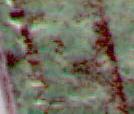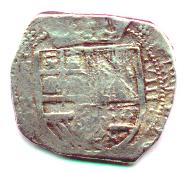
| Philip
IV / Felipe IV
#1856: 8 Reales Assayer P (1627-32) Nuevo Reino 27.448 grams / gramos. | |
A non-sea salvaged coin of classic Santa Fé style. At 27.448 grams, this piece is a mere 22 milligrams below the prescribed weight. Se trata de una moneda que no fue recuperadada del océano. Tiene el estilo característico de Santa Fé. Pesa 27,448gm., sólo 22mgm. menos que el peso oficial.
Obverse: Crowned Habsburg shield, with pomegranate inside a small triangle at bottom. The arms of Castile & Leon are swapped from correct position, the Lion is in the top left quadrant. The mint mark, "NR", and assayer mark "P", are arranged vertically to the left of the shield, albeit the "R" is not visible due to wear. To the right of the shield is the vertical numeral VIII, for the denomination, reading downward. The assayer initial "P", is for Miguel Pinto Camargo, assayer at Santa Fé between 1627 and 1632. The legend around the periphery reads: "+ PHILI(PPVS · IIII · D · G) +". Reverse: Cross surrounded by 8 arcs. In the quarters of the cross are castles and lions, for Castile and Leon, in their proper positions. There is no inner ring between the cross and the legend around the periphery; the legend reads "(+ HIS)PA(N)IA(RVM · REX · 16??)". R/L M44-7, L/R M44S, C&T Type 103. Anverso: Escudo de Habsburgo coronado con granada en el pequeño triángulo de la base. Las insignias de Castilla y de León están en orden incorrecto: el león está en el cuadrante súpero-externo. La marca de ceca "NR" y la inicial del ensayador "P" se encuentran organizadas verticalmente a la izquierda del escudo a pesar de que la "R" no es visible debido a desgaste. A la derecha del escudo aparece el numeral VIII correspondiente a la denominación y el cual se lee de arriba hacia abajo. La inicial del ensayador "P", corresponde a Miguel Pinto Camargo, ensayador en Santa Fe de 1627 a 1632. Alrededor se lee "+PHILI(PPVS.IIII.D.G)+". Reverso: Cruz rodeada por 8 arcos. Los cuarteles están ocupados por castillos y leones en posición correcta. No hay anillo entre la cruz y la leyenda de la periferia en la cual se lee,"(+ HIS)PA(N)IA(RVM · REX · 16??)". R/L M44-7, L/R M44S, C&T Tipo 103. |
|
Distinguishing features of this piece are: (1) The lion / castle order arrangement on the obverse combined with the castle / lion order on the reverse. Dr. Restrepo has assigned catalog number M44-7 to this variety. (2) The extension of the vertical lines for Aragon down to the top of the small shield of Flanders and Tyrol, the same feature as the plate coin dated 1631 in Calicó (1998) type 103 and R/L M44-6. (3) The diagonal lines for Old Burgundy in the lower left portion of the shield are not separated from the horizontal bar for Austria. Como detalles característicos de esta pieza se anotan: (1) El orden de los castillos y leones del anverso combinados con los del reverso. El doctor Restrepo le ha asignado el código M44-7 a esta variedad que no aparece en su catálogo. (2) Llama la atención el hecho de que las líneas verticales de Aragón llegan hasta el escudete de Flandes y Tirol. Lo mismo que se observa en la pieza de 1631 ilustrada por Calicó (1998)tipo 103 y R/L M44-6. (3) Las líneas diagonales de Borgoña Antigua abajo y a la izquierda del escudo no están separadas de la barra horizontal de Austria. |
|
 |
The assayer mark "P" is completely visible, but hard to capture in an image, see enlargement at left. La P de Pinto es visible pero difícil de demostrar en las imágenes. Obsérvese la ampliación a la izquierda. |
©Copyright Herman Blanton 2003, all rights reserved.



